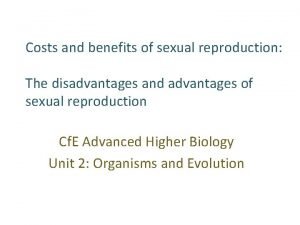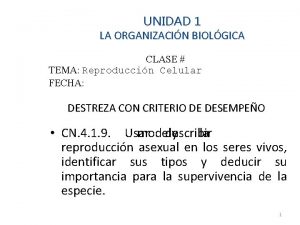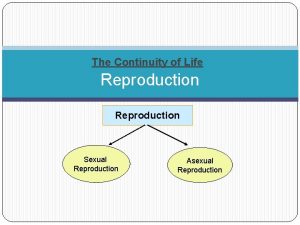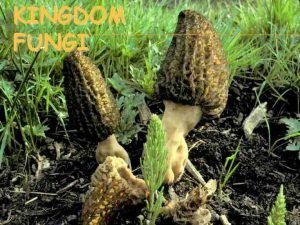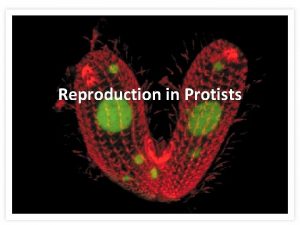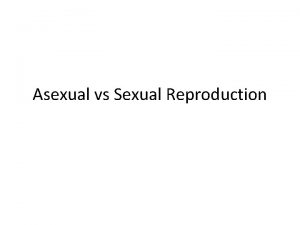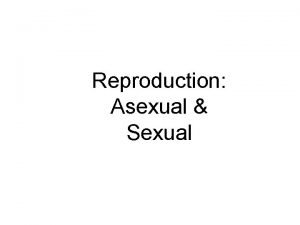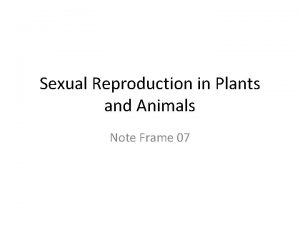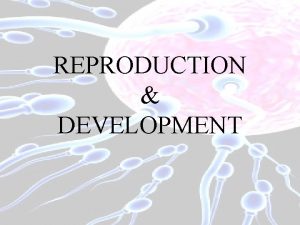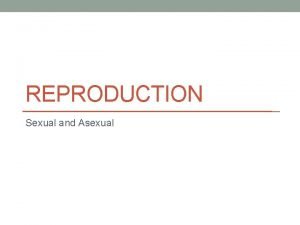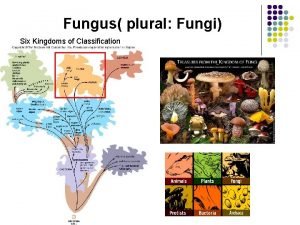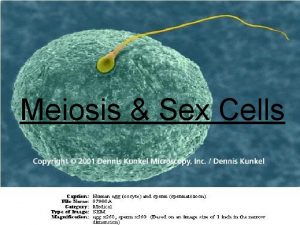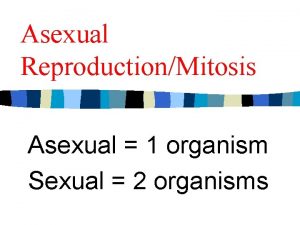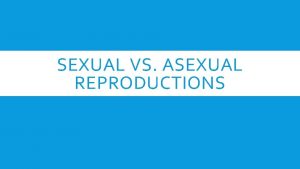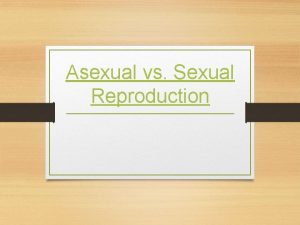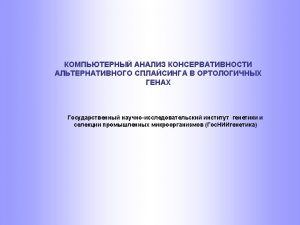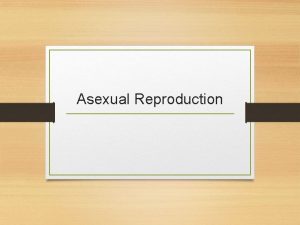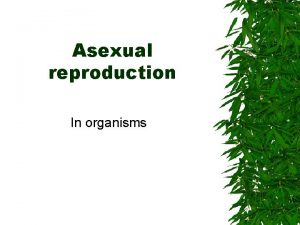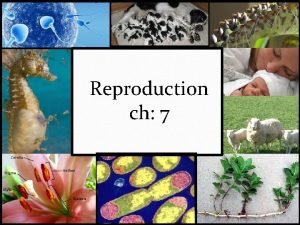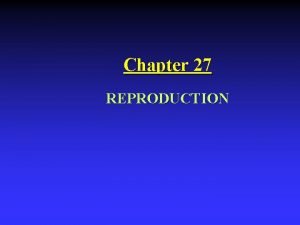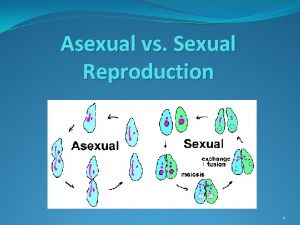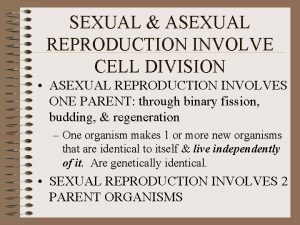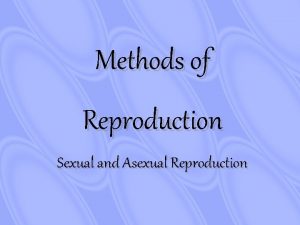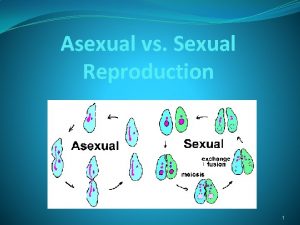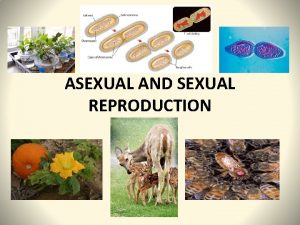Asexual ReproductionMitosis Asexual 1 organism Sexual 2 organisms






















- Slides: 22

Asexual Reproduction/Mitosis Asexual = 1 organism Sexual = 2 organisms

MEMORIZE THESE FACTS n 1. Acquired traits are NOT transferred to offspring. A basketball player develops speed and power as a result of practice. This athletic ability will NOT be passed on to her offspring because: – A. muscle cells do not carry genetic information – B. mutations that occur in body cells are not inherited.

MEMORIZE THESE FACTS n Acquired traits are NOT transferred to offspring. A basketball player develops speed and power as a result of practice. This athletic ability will NOT be passed on to her offspring because: – A. muscle cells do not carry genetic information – B. mutations that occur in body cells are not inherited.

MEMORIZE THESE FACTS!! n Which of the following 2. Asexually examples will produce offspring genetically reproducing identical to the offspring are parents? genetically n A. organisms that reproduce using sex identical to cells. their parents. n B. sexually reproducing organisms n C. asexually reproducing organisms

MEMORIZE THESE FACTS!! n Which of the following 2. Asexually examples will produce offspring genetically reproducing identical to the offspring are parents? genetically n A. organisms that reproduce using sex identical to cells. their parents. n B. sexually reproducing organisms n C. asexually reproducing organisms

MEMORIZE THESE FACTS 3. Asexually reproducing organisms (ex: mitosis) have the least possibility for genetic variation. n The least genetic variation will probably be found in the offspring of organisms that reproduce using: – A. mitosis – B. meiosis – C. fusion of eggs and sperm

MEMORIZE THESE FACTS 3. Asexually reproducing organisms (ex: mitosis) have the least possibility for genetic variation. n The least genetic variation will probably be found in the offspring of organisms that reproduce using: – A. mitosis – B. meiosis – C. fusion of eggs and sperm

MEMORIZE THESE FACTS!! n Which statement is most closely related to the modern theory of Evolution? A. characteristics that are acquired during life are passed to offspring. B. organisms best adapted to a changed environment are more likely to reproduce and pass their genes to offspring. 4. Asexual reproduction does not increase the likelihood of species survival.

MEMORIZE THESE FACTS!! n Which statement is most closely related to the modern theory of Evolution? A. characteristics that are acquired during life are passed to offspring. B. organisms best adapted to a changed environment are more likely to reproduce and pass their genes to offspring. 4. Asexual reproduction does not increase the likelihood of species survival.

MEMORIZE THESE FACTS!! n Some organisms have 5. Asexual become extinct while some still exist. Extinct reproduction organisms: does not n A. did not face a struggle for survival increase the n B. produced offspring that all had identical inheritable evolution characteristics n C. learned to migrate to new rate of an environments. organism.

MEMORIZE THESE FACTS!! n Some organisms have 5. Asexual become extinct while some still exist. Extinct reproduction organisms: does not n A. did not face a struggle for survival increase the n B. produced offspring that all had identical inheritable evolution characteristics n C. learned to migrate to new rate of an environments. organism.

MEMORIZE THESE FACTS!! n Mutated DNA in an 6. Changes in egg cell can be passed to offspring. genetic TRUE OR FALSE information n Mutated DNA in a in sex cells skin cell can be passed to offspring. can be TRUE OR FALSE passed to offspring.

MEMORIZE THESE FACTS!! n Mutated DNA in an 6. Changes in egg cell can be passed to offspring. genetic TRUE OR FALSE information n Mutated DNA in a in sex cells skin cell can be passed to offspring. can be TRUE OR FALSE passed to offspring.

Assessment Which phrase best identifies asexual reproduction? n A. 1 parent, union of gametes. n B. 2 parents, union of gametes n C. 1 parent, no union of gametes n

Assessment Which phrase best identifies asexual reproduction? n A. 1 parent, union of gametes. n B. 2 parents, union of gametes n C. 1 parent, no union of gametes n

Assessment n The ability of cells to pass on their characteristics to new cells is related to its ability to – A. excrete wastes – B. replicate its chromosomes – C. use energy

Assessment n The ability of cells to pass on their characteristics to new cells is related to its ability to – A. excrete wastes – B. replicate its chromosomes – C. use energy

Assessment In budding, the parent cell divides: n A. evenly n B. unevenly n

Assessment In budding, the parent cell divides: n A. evenly n B. unevenly n

Assessment n Release of spores by a mushroom is one type of A. Binary fission B. Gametogenesis C. Meiosis D. Asexual reproduction

Assessment n. A farmer found that one peach tree produced delicious fruit. Which method would provide the fastest crop of these peaches? A. Planting seeds of the peaches from this tree B. Grafting branches from this tree onto other peach tree in this orchard. C. Crossing this trees seeds with another tree in the orchard.

ASSESSMENT: predict the # of chromosomes in the daughter cells or in the parent cell. 46 8 8 8 46 46
 Food webs and energy pyramids worksheet answers
Food webs and energy pyramids worksheet answers Sexual reproduction examples
Sexual reproduction examples Sexual or asexual reproduction
Sexual or asexual reproduction Difference of sexual and asexual reproduction
Difference of sexual and asexual reproduction Organizador grafico de la reproduccion sexual y asexual
Organizador grafico de la reproduccion sexual y asexual Sexual or asexual reproduction
Sexual or asexual reproduction 10 characteristics of fungi
10 characteristics of fungi Reproduction in protists
Reproduction in protists Sexual or asexual reproduction
Sexual or asexual reproduction Asexual or sexual reproduction
Asexual or sexual reproduction Asexual and sexual reproduction difference
Asexual and sexual reproduction difference Hare lynx
Hare lynx Venn diagram asexual vs sexual reproduction
Venn diagram asexual vs sexual reproduction Example asexual reproduction
Example asexual reproduction Asexual or sexual reproduction
Asexual or sexual reproduction Asexual or sexual reproduction
Asexual or sexual reproduction Asexual and sexual reproduction venn diagram
Asexual and sexual reproduction venn diagram Budding asexual reproduction
Budding asexual reproduction Fungus en plural
Fungus en plural Binary fission in bacteria
Binary fission in bacteria Sexual and asexual reproduction
Sexual and asexual reproduction Venn diagram asexual and sexual reproduction
Venn diagram asexual and sexual reproduction Bacteria sexual or asexual
Bacteria sexual or asexual


